-
 A Sunday Times welcome letter to war brides coming to Western Australia
A Sunday Times welcome letter to war brides coming to Western Australia An article welcoming war brides to Western Australia and giving them advice.
-
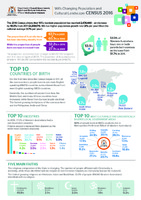 WA’s Changing Population and Cultural Landscape: CENSUS 2016
WA’s Changing Population and Cultural Landscape: CENSUS 2016 An infographic developed by OMI that showcases key information from 2016 Census
-
 Choral performance and clay pot tapping performance of the Twa refugee community of Katanning
Choral performance and clay pot tapping performance of the Twa refugee community of Katanning
The Twa people are a small ethnic group originally from Burundi who fled their homeland in the 1990s because of ethnic persecution. They lived in refugee camps in Tanzania for many years before being relocated to Australia as refugees. They have settled in Katanning to create a new life for themselves. A large part of their culture revolves around music and singing and they have formed the Burundi Band and Peace Choir. They are Christians and use the space at the local church and the old railway station to gather and perform, worship and practice. This record comprises:- sound recordings of performances of the TWA community choir and women community members playing clay pot musical instruments.
-
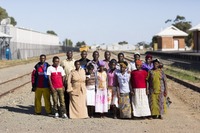 Burundi Band and Peace Choir, members of the Twa community, pose near the old train station, Katanning
Burundi Band and Peace Choir, members of the Twa community, pose near the old train station, Katanning
The Twa people are a small ethnic group originally from Burundi who fled their homeland in the 1990s because of ethnic persecution. They lived in refugee camps in Tanzania for many years before being relocated to Australia as refugees. They have settled in Katanning to create a new life for themselves. A large part of their culture revolves around music and singing and they have formed the Burundi Band and Peace Choir. They are Christians and use the space at the local church and the old railway station to gather and perform, worship and practice. This selection of photographs shows individuals, family and community groups in and around their homes, at church, at the local pool, in town, rehearsing and performing.
-
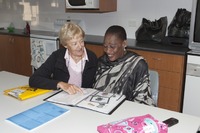 English class at Edmund Rice Centre, Mirrabooka.
English class at Edmund Rice Centre, Mirrabooka. Terry Farquarso (left) teacher and student Samai Mustafa. The Edmund Rice Centre Mirrabooka Inc. is a non-government, incorporated, not-for-profit, charitable organisation and a ministry of the Trustees of the Christian Brothers Oceania. The Edmund Rice Centre was established in March 1998 to support Humanitarian Entrants and Indigenous families through the provision of educational programs and community development activities.
-
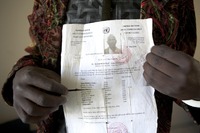 Dondon Malith's UNHCR refugee papers
Dondon Malith's UNHCR refugee papers Dondon Malith a Sudanese refugee also known as one of the “lost boys of Sudan”. Dondon has studied Politics and international Studies at Murdoch University in WA .
-
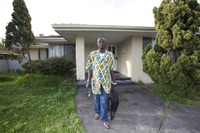 Sudanese refugee Dondon Malith at home in Balcatta
Sudanese refugee Dondon Malith at home in Balcatta Dondon Malith a Sudanese refugee also known as one of the “lost boys of Sudan”. Dondon has studied Politics and international Studies at Murdoch University in WA
-
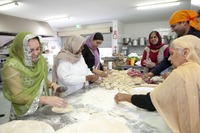 Volunteers make chapattis in the communal kitchen of the Gurdwara Sahib of Western Australia
Volunteers make chapattis in the communal kitchen of the Gurdwara Sahib of Western Australia Langar, which is a tradition of the Sikhs; everyone irrespective of their caste, skin colour, nationality, social, financial or political status, to sit together for a meal. The Langar is always vegetarian, and traditionally is made up of simple, nourishing food. Ceremonies are held on a Sundays and usually about 500 Sikhs from the community share a vegetarian meal. The meal is cooked in the large purpose built kitchen. Members of the community take turns to cook vegetarian food, a head chef is appointed each week to supervise the cooking process. In the Gurdwara, no shoes are worn and the head must be covered at all times as a mark of respect. Gurdwara Sahib of Western Australia and Sikh Association of Western Australia.
-
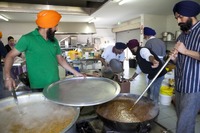 Volunteers of the Sikh community make a vegetarian meal for about 500 people
Volunteers of the Sikh community make a vegetarian meal for about 500 people Langar, which is a tradition of the Sikhs; everyone irrespective of their caste, skin colour, nationality, social, financial or political status, to sit together for a meal. The Langar is always vegetarian, and traditionally is made up of simple, nourishing food. Ceremonies are held on a Sundays and usually about 500 Sikhs from the community share a vegetarian meal. The meal is cooked in the large purpose built kitchen. Members of the community take turns to cook vegetarian food, a head chef is appointed each week to supervise the cooking process. In the Gurdwara, no shoes are worn and the head must be covered at all times as a mark of respect. Gurdwara Sahib of Western Australia and Sikh Association of Western Australia.
-
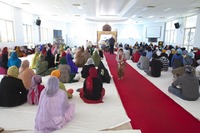 Inside the Gurdwara Sahib of Western Australia
Inside the Gurdwara Sahib of Western Australia Langar, which is a tradition of the Sikhs; everyone irrespective of their caste, skin colour, nationality, social, financial or political status, to sit together for a meal. The Langar is always vegetarian, and traditionally is made up of simple, nourishing food. Ceremonies are held on a Sundays and usually about 500 Sikhs from the community share a vegetarian meal. The meal is cooked in the large purpose built kitchen. Members of the community take turns to cook vegetarian food, a head chef is appointed each week to supervise the cooking process. In the Gurdwara, no shoes are worn and the head must be covered at all times as a mark of respect. Gurdwara Sahib of Western Australia and Sikh Association of Western Australia. Sunday 23rd September - Louise Whelan.
-
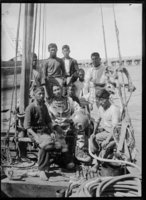 Japanese pearl diver and lugger crew, Broome 1911
Japanese pearl diver and lugger crew, Broome 1911 From a series of photographs taken in Broome during 1909-1911 including unidentified Japanese people and buildings, luggers, pearling crews and divers, and Gantheaume Point.
-
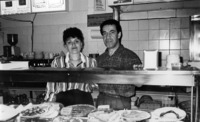 Heshmet and Ruha Beyzaie owners of Caspian Delight Coffee Shop, Geraldton
Heshmet and Ruha Beyzaie owners of Caspian Delight Coffee Shop, Geraldton
-
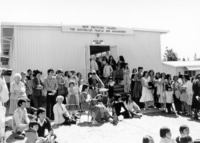 Vietnamese migrants outside the Graylands Migrant Centre
Vietnamese migrants outside the Graylands Migrant Centre
-
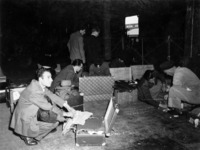 Customs officers search luggage, May 1953
Customs officers search luggage, May 1953 Customs officer searching migrant's luggage.
-
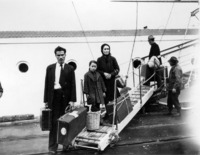 An immigrant family with luggage disembark, May 1953
An immigrant family with luggage disembark, May 1953 A migrant family walk down the gangway with their luggage.
-
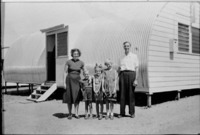 Johanna, Wietze (Jnr), Gerda, Helene and Wietze de Boer at Graylands Migrant Hostel, Christmas 1953
Johanna, Wietze (Jnr), Gerda, Helene and Wietze de Boer at Graylands Migrant Hostel, Christmas 1953
-
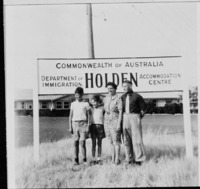 John, Matthew, Elizabeth and Hendrick van Welie, from the Netherlands, outside the Holden Immigration Accommodation Centre
John, Matthew, Elizabeth and Hendrick van Welie, from the Netherlands, outside the Holden Immigration Accommodation Centre
-
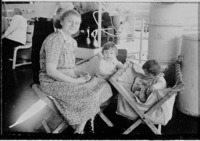 Jadwiga Ziembinski with her twins Zdislaw and Barbara on board the Skaugum coming to Australia
Jadwiga Ziembinski with her twins Zdislaw and Barbara on board the Skaugum coming to Australia
-
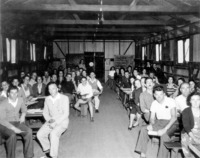 Adult English class, 1950
Adult English class, 1950 Northam Immigration Camp adult class learning English
-
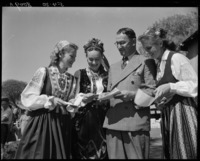 People at Northam migrant camp with women dressed in national costume
People at Northam migrant camp with women dressed in national costume Mr R Shilkin in Northam with Biruta Zelkins, Katherine Juszczuk, Maiga Zilite discussing the National Savings Scheme.
-
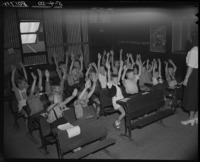 Teacher and class, 1950
Teacher and class, 1950 Female teacher at the front of class. Students all seated with both arms raised, at Holden (Northam) camp.
-
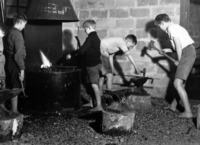 Boys from the British Child Migration Scheme at the forge, Fairbridge Farm
Boys from the British Child Migration Scheme at the forge, Fairbridge Farm
-
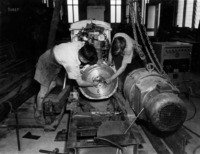 Motor mechanics, 1952
Motor mechanics, 1952 Boys fixing a motor at Bindoon Boys Town
-
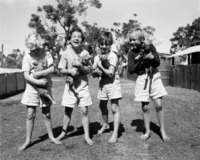 Children and piglets, Fairbridge Farm, 1954
Children and piglets, Fairbridge Farm, 1954 Four children holding piglets and laughing at Fairbridge Farm school, Pinjarra, WA.
-
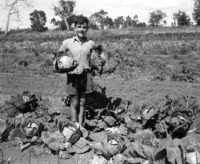 Picking cabbages, Fairbridge Farm, 1954
Picking cabbages, Fairbridge Farm, 1954 A boy picking cabbages at Fairbridge Farm school at Pinjarra, WA.
-
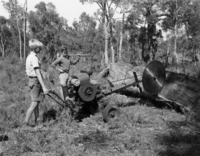 Sawing a log, Fairbridge Farm, 1954
Sawing a log, Fairbridge Farm, 1954 Two boys sawing a log at Fairbridge Farm school in Pinjarra.
-
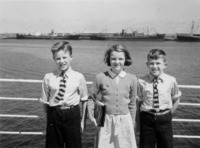 Arrival of children on the Ormonde bound for Fairbridge Farm School, Nov. 1950
Arrival of children on the Ormonde bound for Fairbridge Farm School, Nov. 1950 Two boys and a girl together with other boats as back drop
-
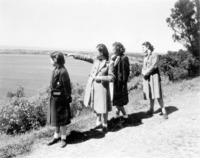 Children on the Asturias arriving in Western Australia, October 1950
Children on the Asturias arriving in Western Australia, October 1950 King's Park on arrival
-
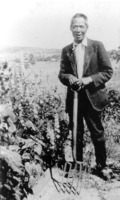 Chung Ah Sue in his market garden, York
Chung Ah Sue in his market garden, York
-
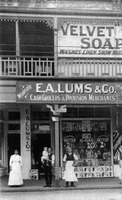 E.A. Lums & Co Cash Grocers and Provision Merchants, Subiaco
E.A. Lums & Co Cash Grocers and Provision Merchants, Subiaco Emily Lums, Charles Lums with baby Oswald and shop assistants stand in front of the shop.
-
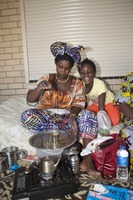 After the meal the women made traditional tea with mint, sugar and tea leaves
After the meal the women made traditional tea with mint, sugar and tea leaves The Senegalese Community of WA gather together on a fortnightly basis to meet and discuss any problems or issues within the community or in individual families. The community also share a meal together. Families take it in turn to host the event. I was invited to share a meal with the community. Women and men eat in separate areas. We ate traditional Senegalese food consisting of a fish, chilli and vegetable dish cooked with rice in a tomato stock. The food is eaten with one hand out of a communal bowl. After the meal was finished the women made some traditional tea with, mint and sugar and tea leaves. Tea was served to the men whilst they played cards. The women helped each other modify their wigs, which have been imported from Senegal. The clothing worn is also traditional clothing from Senegal. The men stopped for prayer after lunch. Saturday 29th September 2012. - Louise Whelan.
-
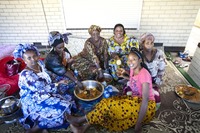 Women and men eat in separate areas, food is eaten with one hand from a communal bowl
Women and men eat in separate areas, food is eaten with one hand from a communal bowl The Senegalese Community of WA gather together on a fortnightly basis to meet and discuss any problems or issues within the community or in individual families. The community also share a meal together. Families take it in turn to host the event. I was invited to share a meal with the community. Women and men eat in separate areas. We ate traditional Senegalese food consisting of a fish, chilli and vegetable dish cooked with rice in a tomato stock. The food is eaten with one hand out of a communal bowl. After the meal was finished the women made some traditional tea with, mint and sugar and tea leaves. Tea was served to the men whilst they played cards. The women helped each other modify their wigs, which have been imported from Senegal. The clothing worn is also traditional clothing from Senegal. The men stopped for prayer after lunch. Saturday 29th September 2012. - Louise Whelan.
-
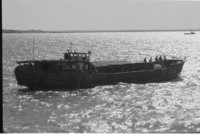 Second boatload of Vietnamese boat people to arrive in Broome
Second boatload of Vietnamese boat people to arrive in Broome Photograph of a boat bringing Vietnamese refugees to Australia
-
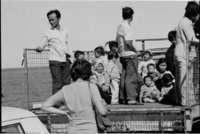 Refugees from the second boatload of Vietnamese boat people to arrive in Broome
Refugees from the second boatload of Vietnamese boat people to arrive in Broome Refugees from Vietnam, including children, shown on the back of a truck after arriving by boat into Broome.
-
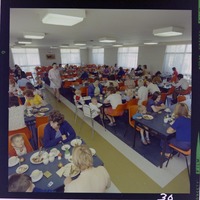 The dining room of Noalimba Reception Centre for immigrants to Western Australia, April 1974
The dining room of Noalimba Reception Centre for immigrants to Western Australia, April 1974 One of a series of photographs of the centre and hostel for migrants to Western Australia. The kindergarden, the kitchen with chef Perce Gibbs, the dining room and the accommodation.
-
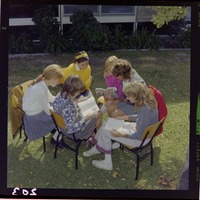 Migrant children with their reading books, Perth, April 1974
Migrant children with their reading books, Perth, April 1974 An image from a series of photographs of new immigrants to W.A., working, playing and studying. None of the individuals have been identified. Part of a series taken for the Premiers Dept. which included photographs of Noalimba.
-
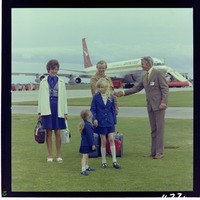 An immigrant family arrives at Perth Airport, April 1974
An immigrant family arrives at Perth Airport, April 1974 An image from a series of photographs of new immigrants to W.A., working, playing and studying. None of the individuals have been identified. Part of a series taken for the Premiers Dept. which included photographs of Noalimba.
-
 Boring trees for blasting on Group 7
Boring trees for blasting on Group 7
-
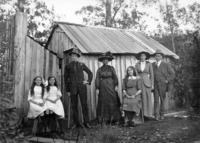 Settlers in front of a bush hut made from sawmill offcuts
Settlers in front of a bush hut made from sawmill offcuts
-
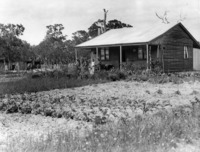 A settler's first home on the group
A settler's first home on the group
-
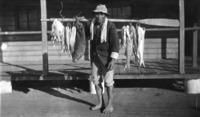 A Chinese fisherman, Broome
A Chinese fisherman, Broome
-
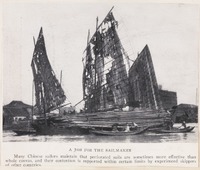 A job for the sailmaker
A job for the sailmaker Caption reads, in part: Many Chinese sailors maintain that perforated sails are sometimes more effective than whole canvas, and their contention is sometimes supported by skippers of other countries.
-
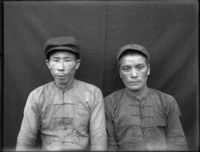 Chong Sium Li and Ah Yung, Chinese sailors, Western Australia
Chong Sium Li and Ah Yung, Chinese sailors, Western Australia Names written under each man on back of negative: Chong Sium Li (at left) and Ah Yung (right)
-
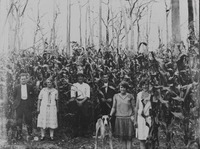 The Pascoe family of Group Settlement Scheme Group 116 in front of their maize crop, Tingledale, Western Australia
The Pascoe family of Group Settlement Scheme Group 116 in front of their maize crop, Tingledale, Western Australia
-
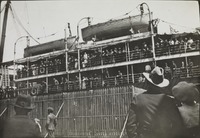 War brides arriving at Fremantle on the Osterley
War brides arriving at Fremantle on the Osterley
-
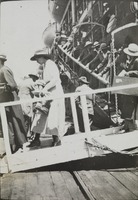 A war bride walks down the gangway from the Osterley
A war bride walks down the gangway from the Osterley
-
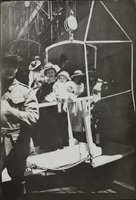 A war bride with a child disembarks the Osterley, Fremantle
A war bride with a child disembarks the Osterley, Fremantle
-
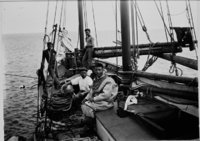 Diver in weighted boots on pearling lugger
Diver in weighted boots on pearling lugger Pearl diver in his suit and weighted boots, 1910
-
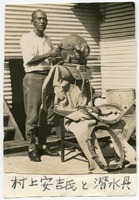 Yasukichi Murakami with diving suit
Yasukichi Murakami with diving suit Yasukichi Murakami with diving suit. The Japanese on the bottom reads Mr Yasukichi Murakami and diving equipment.
-
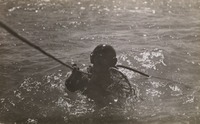 Diver just coming up
Diver just coming up Pearl diver emerging from the water, Broome, ca. 1925.
-
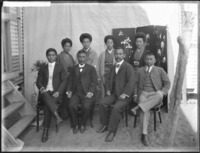 Members of the Japanese community in Broome
Members of the Japanese community in Broome
-
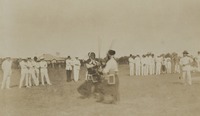 A kendo match, Broome
A kendo match, Broome
-
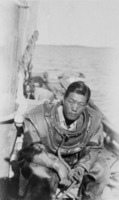 Japanese pearl diver working off Broome
Japanese pearl diver working off Broome
-
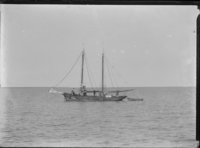 Pearling lugger B261, Broome, ca. 1910
Pearling lugger B261, Broome, ca. 1910
-
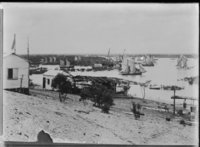 The pearling fleet at Broome, 1910
The pearling fleet at Broome, 1910
-
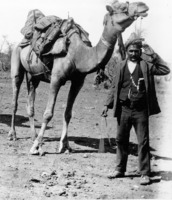 Fazzledine and his camel, Oct. 1904
Fazzledine and his camel, Oct. 1904 An Afghan camel driver at Murrin Murrin.
-
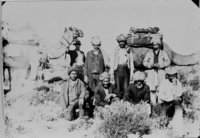 Asians and Afghans in Eucla with camels
Asians and Afghans in Eucla with camels
-
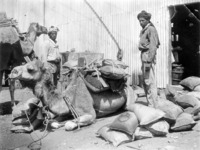 Afghans loading tin concentrate onto camels
Afghans loading tin concentrate onto camels
 A Sunday Times welcome letter to war brides coming to Western Australia An article welcoming war brides to Western Australia and giving them advice.
A Sunday Times welcome letter to war brides coming to Western Australia An article welcoming war brides to Western Australia and giving them advice. WA’s Changing Population and Cultural Landscape: CENSUS 2016 An infographic developed by OMI that showcases key information from 2016 Census
WA’s Changing Population and Cultural Landscape: CENSUS 2016 An infographic developed by OMI that showcases key information from 2016 Census Choral performance and clay pot tapping performance of the Twa refugee community of Katanning The Twa people are a small ethnic group originally from Burundi who fled their homeland in the 1990s because of ethnic persecution. They lived in refugee camps in Tanzania for many years before being relocated to Australia as refugees. They have settled in Katanning to create a new life for themselves. A large part of their culture revolves around music and singing and they have formed the Burundi Band and Peace Choir. They are Christians and use the space at the local church and the old railway station to gather and perform, worship and practice. This record comprises:- sound recordings of performances of the TWA community choir and women community members playing clay pot musical instruments.
Choral performance and clay pot tapping performance of the Twa refugee community of Katanning The Twa people are a small ethnic group originally from Burundi who fled their homeland in the 1990s because of ethnic persecution. They lived in refugee camps in Tanzania for many years before being relocated to Australia as refugees. They have settled in Katanning to create a new life for themselves. A large part of their culture revolves around music and singing and they have formed the Burundi Band and Peace Choir. They are Christians and use the space at the local church and the old railway station to gather and perform, worship and practice. This record comprises:- sound recordings of performances of the TWA community choir and women community members playing clay pot musical instruments. Burundi Band and Peace Choir, members of the Twa community, pose near the old train station, Katanning The Twa people are a small ethnic group originally from Burundi who fled their homeland in the 1990s because of ethnic persecution. They lived in refugee camps in Tanzania for many years before being relocated to Australia as refugees. They have settled in Katanning to create a new life for themselves. A large part of their culture revolves around music and singing and they have formed the Burundi Band and Peace Choir. They are Christians and use the space at the local church and the old railway station to gather and perform, worship and practice. This selection of photographs shows individuals, family and community groups in and around their homes, at church, at the local pool, in town, rehearsing and performing.
Burundi Band and Peace Choir, members of the Twa community, pose near the old train station, Katanning The Twa people are a small ethnic group originally from Burundi who fled their homeland in the 1990s because of ethnic persecution. They lived in refugee camps in Tanzania for many years before being relocated to Australia as refugees. They have settled in Katanning to create a new life for themselves. A large part of their culture revolves around music and singing and they have formed the Burundi Band and Peace Choir. They are Christians and use the space at the local church and the old railway station to gather and perform, worship and practice. This selection of photographs shows individuals, family and community groups in and around their homes, at church, at the local pool, in town, rehearsing and performing. English class at Edmund Rice Centre, Mirrabooka. Terry Farquarso (left) teacher and student Samai Mustafa. The Edmund Rice Centre Mirrabooka Inc. is a non-government, incorporated, not-for-profit, charitable organisation and a ministry of the Trustees of the Christian Brothers Oceania. The Edmund Rice Centre was established in March 1998 to support Humanitarian Entrants and Indigenous families through the provision of educational programs and community development activities.
English class at Edmund Rice Centre, Mirrabooka. Terry Farquarso (left) teacher and student Samai Mustafa. The Edmund Rice Centre Mirrabooka Inc. is a non-government, incorporated, not-for-profit, charitable organisation and a ministry of the Trustees of the Christian Brothers Oceania. The Edmund Rice Centre was established in March 1998 to support Humanitarian Entrants and Indigenous families through the provision of educational programs and community development activities. Dondon Malith's UNHCR refugee papers Dondon Malith a Sudanese refugee also known as one of the “lost boys of Sudan”. Dondon has studied Politics and international Studies at Murdoch University in WA .
Dondon Malith's UNHCR refugee papers Dondon Malith a Sudanese refugee also known as one of the “lost boys of Sudan”. Dondon has studied Politics and international Studies at Murdoch University in WA . Sudanese refugee Dondon Malith at home in Balcatta Dondon Malith a Sudanese refugee also known as one of the “lost boys of Sudan”. Dondon has studied Politics and international Studies at Murdoch University in WA
Sudanese refugee Dondon Malith at home in Balcatta Dondon Malith a Sudanese refugee also known as one of the “lost boys of Sudan”. Dondon has studied Politics and international Studies at Murdoch University in WA Volunteers make chapattis in the communal kitchen of the Gurdwara Sahib of Western Australia Langar, which is a tradition of the Sikhs; everyone irrespective of their caste, skin colour, nationality, social, financial or political status, to sit together for a meal. The Langar is always vegetarian, and traditionally is made up of simple, nourishing food. Ceremonies are held on a Sundays and usually about 500 Sikhs from the community share a vegetarian meal. The meal is cooked in the large purpose built kitchen. Members of the community take turns to cook vegetarian food, a head chef is appointed each week to supervise the cooking process. In the Gurdwara, no shoes are worn and the head must be covered at all times as a mark of respect. Gurdwara Sahib of Western Australia and Sikh Association of Western Australia.
Volunteers make chapattis in the communal kitchen of the Gurdwara Sahib of Western Australia Langar, which is a tradition of the Sikhs; everyone irrespective of their caste, skin colour, nationality, social, financial or political status, to sit together for a meal. The Langar is always vegetarian, and traditionally is made up of simple, nourishing food. Ceremonies are held on a Sundays and usually about 500 Sikhs from the community share a vegetarian meal. The meal is cooked in the large purpose built kitchen. Members of the community take turns to cook vegetarian food, a head chef is appointed each week to supervise the cooking process. In the Gurdwara, no shoes are worn and the head must be covered at all times as a mark of respect. Gurdwara Sahib of Western Australia and Sikh Association of Western Australia. Volunteers of the Sikh community make a vegetarian meal for about 500 people Langar, which is a tradition of the Sikhs; everyone irrespective of their caste, skin colour, nationality, social, financial or political status, to sit together for a meal. The Langar is always vegetarian, and traditionally is made up of simple, nourishing food. Ceremonies are held on a Sundays and usually about 500 Sikhs from the community share a vegetarian meal. The meal is cooked in the large purpose built kitchen. Members of the community take turns to cook vegetarian food, a head chef is appointed each week to supervise the cooking process. In the Gurdwara, no shoes are worn and the head must be covered at all times as a mark of respect. Gurdwara Sahib of Western Australia and Sikh Association of Western Australia.
Volunteers of the Sikh community make a vegetarian meal for about 500 people Langar, which is a tradition of the Sikhs; everyone irrespective of their caste, skin colour, nationality, social, financial or political status, to sit together for a meal. The Langar is always vegetarian, and traditionally is made up of simple, nourishing food. Ceremonies are held on a Sundays and usually about 500 Sikhs from the community share a vegetarian meal. The meal is cooked in the large purpose built kitchen. Members of the community take turns to cook vegetarian food, a head chef is appointed each week to supervise the cooking process. In the Gurdwara, no shoes are worn and the head must be covered at all times as a mark of respect. Gurdwara Sahib of Western Australia and Sikh Association of Western Australia. Inside the Gurdwara Sahib of Western Australia Langar, which is a tradition of the Sikhs; everyone irrespective of their caste, skin colour, nationality, social, financial or political status, to sit together for a meal. The Langar is always vegetarian, and traditionally is made up of simple, nourishing food. Ceremonies are held on a Sundays and usually about 500 Sikhs from the community share a vegetarian meal. The meal is cooked in the large purpose built kitchen. Members of the community take turns to cook vegetarian food, a head chef is appointed each week to supervise the cooking process. In the Gurdwara, no shoes are worn and the head must be covered at all times as a mark of respect. Gurdwara Sahib of Western Australia and Sikh Association of Western Australia. Sunday 23rd September - Louise Whelan.
Inside the Gurdwara Sahib of Western Australia Langar, which is a tradition of the Sikhs; everyone irrespective of their caste, skin colour, nationality, social, financial or political status, to sit together for a meal. The Langar is always vegetarian, and traditionally is made up of simple, nourishing food. Ceremonies are held on a Sundays and usually about 500 Sikhs from the community share a vegetarian meal. The meal is cooked in the large purpose built kitchen. Members of the community take turns to cook vegetarian food, a head chef is appointed each week to supervise the cooking process. In the Gurdwara, no shoes are worn and the head must be covered at all times as a mark of respect. Gurdwara Sahib of Western Australia and Sikh Association of Western Australia. Sunday 23rd September - Louise Whelan. Japanese pearl diver and lugger crew, Broome 1911 From a series of photographs taken in Broome during 1909-1911 including unidentified Japanese people and buildings, luggers, pearling crews and divers, and Gantheaume Point.
Japanese pearl diver and lugger crew, Broome 1911 From a series of photographs taken in Broome during 1909-1911 including unidentified Japanese people and buildings, luggers, pearling crews and divers, and Gantheaume Point. Heshmet and Ruha Beyzaie owners of Caspian Delight Coffee Shop, Geraldton
Heshmet and Ruha Beyzaie owners of Caspian Delight Coffee Shop, Geraldton  Vietnamese migrants outside the Graylands Migrant Centre
Vietnamese migrants outside the Graylands Migrant Centre  Customs officers search luggage, May 1953 Customs officer searching migrant's luggage.
Customs officers search luggage, May 1953 Customs officer searching migrant's luggage. An immigrant family with luggage disembark, May 1953 A migrant family walk down the gangway with their luggage.
An immigrant family with luggage disembark, May 1953 A migrant family walk down the gangway with their luggage. Johanna, Wietze (Jnr), Gerda, Helene and Wietze de Boer at Graylands Migrant Hostel, Christmas 1953
Johanna, Wietze (Jnr), Gerda, Helene and Wietze de Boer at Graylands Migrant Hostel, Christmas 1953  John, Matthew, Elizabeth and Hendrick van Welie, from the Netherlands, outside the Holden Immigration Accommodation Centre
John, Matthew, Elizabeth and Hendrick van Welie, from the Netherlands, outside the Holden Immigration Accommodation Centre  Jadwiga Ziembinski with her twins Zdislaw and Barbara on board the Skaugum coming to Australia
Jadwiga Ziembinski with her twins Zdislaw and Barbara on board the Skaugum coming to Australia  Adult English class, 1950 Northam Immigration Camp adult class learning English
Adult English class, 1950 Northam Immigration Camp adult class learning English People at Northam migrant camp with women dressed in national costume Mr R Shilkin in Northam with Biruta Zelkins, Katherine Juszczuk, Maiga Zilite discussing the National Savings Scheme.
People at Northam migrant camp with women dressed in national costume Mr R Shilkin in Northam with Biruta Zelkins, Katherine Juszczuk, Maiga Zilite discussing the National Savings Scheme. Teacher and class, 1950 Female teacher at the front of class. Students all seated with both arms raised, at Holden (Northam) camp.
Teacher and class, 1950 Female teacher at the front of class. Students all seated with both arms raised, at Holden (Northam) camp. Boys from the British Child Migration Scheme at the forge, Fairbridge Farm
Boys from the British Child Migration Scheme at the forge, Fairbridge Farm  Motor mechanics, 1952 Boys fixing a motor at Bindoon Boys Town
Motor mechanics, 1952 Boys fixing a motor at Bindoon Boys Town Children and piglets, Fairbridge Farm, 1954 Four children holding piglets and laughing at Fairbridge Farm school, Pinjarra, WA.
Children and piglets, Fairbridge Farm, 1954 Four children holding piglets and laughing at Fairbridge Farm school, Pinjarra, WA. Picking cabbages, Fairbridge Farm, 1954 A boy picking cabbages at Fairbridge Farm school at Pinjarra, WA.
Picking cabbages, Fairbridge Farm, 1954 A boy picking cabbages at Fairbridge Farm school at Pinjarra, WA. Sawing a log, Fairbridge Farm, 1954 Two boys sawing a log at Fairbridge Farm school in Pinjarra.
Sawing a log, Fairbridge Farm, 1954 Two boys sawing a log at Fairbridge Farm school in Pinjarra. Arrival of children on the Ormonde bound for Fairbridge Farm School, Nov. 1950 Two boys and a girl together with other boats as back drop
Arrival of children on the Ormonde bound for Fairbridge Farm School, Nov. 1950 Two boys and a girl together with other boats as back drop Children on the Asturias arriving in Western Australia, October 1950 King's Park on arrival
Children on the Asturias arriving in Western Australia, October 1950 King's Park on arrival Chung Ah Sue in his market garden, York
Chung Ah Sue in his market garden, York  E.A. Lums & Co Cash Grocers and Provision Merchants, Subiaco Emily Lums, Charles Lums with baby Oswald and shop assistants stand in front of the shop.
E.A. Lums & Co Cash Grocers and Provision Merchants, Subiaco Emily Lums, Charles Lums with baby Oswald and shop assistants stand in front of the shop. After the meal the women made traditional tea with mint, sugar and tea leaves The Senegalese Community of WA gather together on a fortnightly basis to meet and discuss any problems or issues within the community or in individual families. The community also share a meal together. Families take it in turn to host the event. I was invited to share a meal with the community. Women and men eat in separate areas. We ate traditional Senegalese food consisting of a fish, chilli and vegetable dish cooked with rice in a tomato stock. The food is eaten with one hand out of a communal bowl. After the meal was finished the women made some traditional tea with, mint and sugar and tea leaves. Tea was served to the men whilst they played cards. The women helped each other modify their wigs, which have been imported from Senegal. The clothing worn is also traditional clothing from Senegal. The men stopped for prayer after lunch. Saturday 29th September 2012. - Louise Whelan.
After the meal the women made traditional tea with mint, sugar and tea leaves The Senegalese Community of WA gather together on a fortnightly basis to meet and discuss any problems or issues within the community or in individual families. The community also share a meal together. Families take it in turn to host the event. I was invited to share a meal with the community. Women and men eat in separate areas. We ate traditional Senegalese food consisting of a fish, chilli and vegetable dish cooked with rice in a tomato stock. The food is eaten with one hand out of a communal bowl. After the meal was finished the women made some traditional tea with, mint and sugar and tea leaves. Tea was served to the men whilst they played cards. The women helped each other modify their wigs, which have been imported from Senegal. The clothing worn is also traditional clothing from Senegal. The men stopped for prayer after lunch. Saturday 29th September 2012. - Louise Whelan. Women and men eat in separate areas, food is eaten with one hand from a communal bowl The Senegalese Community of WA gather together on a fortnightly basis to meet and discuss any problems or issues within the community or in individual families. The community also share a meal together. Families take it in turn to host the event. I was invited to share a meal with the community. Women and men eat in separate areas. We ate traditional Senegalese food consisting of a fish, chilli and vegetable dish cooked with rice in a tomato stock. The food is eaten with one hand out of a communal bowl. After the meal was finished the women made some traditional tea with, mint and sugar and tea leaves. Tea was served to the men whilst they played cards. The women helped each other modify their wigs, which have been imported from Senegal. The clothing worn is also traditional clothing from Senegal. The men stopped for prayer after lunch. Saturday 29th September 2012. - Louise Whelan.
Women and men eat in separate areas, food is eaten with one hand from a communal bowl The Senegalese Community of WA gather together on a fortnightly basis to meet and discuss any problems or issues within the community or in individual families. The community also share a meal together. Families take it in turn to host the event. I was invited to share a meal with the community. Women and men eat in separate areas. We ate traditional Senegalese food consisting of a fish, chilli and vegetable dish cooked with rice in a tomato stock. The food is eaten with one hand out of a communal bowl. After the meal was finished the women made some traditional tea with, mint and sugar and tea leaves. Tea was served to the men whilst they played cards. The women helped each other modify their wigs, which have been imported from Senegal. The clothing worn is also traditional clothing from Senegal. The men stopped for prayer after lunch. Saturday 29th September 2012. - Louise Whelan. Second boatload of Vietnamese boat people to arrive in Broome Photograph of a boat bringing Vietnamese refugees to Australia
Second boatload of Vietnamese boat people to arrive in Broome Photograph of a boat bringing Vietnamese refugees to Australia Refugees from the second boatload of Vietnamese boat people to arrive in Broome Refugees from Vietnam, including children, shown on the back of a truck after arriving by boat into Broome.
Refugees from the second boatload of Vietnamese boat people to arrive in Broome Refugees from Vietnam, including children, shown on the back of a truck after arriving by boat into Broome. The dining room of Noalimba Reception Centre for immigrants to Western Australia, April 1974 One of a series of photographs of the centre and hostel for migrants to Western Australia. The kindergarden, the kitchen with chef Perce Gibbs, the dining room and the accommodation.
The dining room of Noalimba Reception Centre for immigrants to Western Australia, April 1974 One of a series of photographs of the centre and hostel for migrants to Western Australia. The kindergarden, the kitchen with chef Perce Gibbs, the dining room and the accommodation. Migrant children with their reading books, Perth, April 1974 An image from a series of photographs of new immigrants to W.A., working, playing and studying. None of the individuals have been identified. Part of a series taken for the Premiers Dept. which included photographs of Noalimba.
Migrant children with their reading books, Perth, April 1974 An image from a series of photographs of new immigrants to W.A., working, playing and studying. None of the individuals have been identified. Part of a series taken for the Premiers Dept. which included photographs of Noalimba. An immigrant family arrives at Perth Airport, April 1974 An image from a series of photographs of new immigrants to W.A., working, playing and studying. None of the individuals have been identified. Part of a series taken for the Premiers Dept. which included photographs of Noalimba.
An immigrant family arrives at Perth Airport, April 1974 An image from a series of photographs of new immigrants to W.A., working, playing and studying. None of the individuals have been identified. Part of a series taken for the Premiers Dept. which included photographs of Noalimba. Boring trees for blasting on Group 7
Boring trees for blasting on Group 7  Settlers in front of a bush hut made from sawmill offcuts
Settlers in front of a bush hut made from sawmill offcuts  A settler's first home on the group
A settler's first home on the group  A Chinese fisherman, Broome
A Chinese fisherman, Broome  A job for the sailmaker Caption reads, in part: Many Chinese sailors maintain that perforated sails are sometimes more effective than whole canvas, and their contention is sometimes supported by skippers of other countries.
A job for the sailmaker Caption reads, in part: Many Chinese sailors maintain that perforated sails are sometimes more effective than whole canvas, and their contention is sometimes supported by skippers of other countries. Chong Sium Li and Ah Yung, Chinese sailors, Western Australia Names written under each man on back of negative: Chong Sium Li (at left) and Ah Yung (right)
Chong Sium Li and Ah Yung, Chinese sailors, Western Australia Names written under each man on back of negative: Chong Sium Li (at left) and Ah Yung (right) The Pascoe family of Group Settlement Scheme Group 116 in front of their maize crop, Tingledale, Western Australia
The Pascoe family of Group Settlement Scheme Group 116 in front of their maize crop, Tingledale, Western Australia  War brides arriving at Fremantle on the Osterley
War brides arriving at Fremantle on the Osterley  A war bride walks down the gangway from the Osterley
A war bride walks down the gangway from the Osterley  A war bride with a child disembarks the Osterley, Fremantle
A war bride with a child disembarks the Osterley, Fremantle  Diver in weighted boots on pearling lugger Pearl diver in his suit and weighted boots, 1910
Diver in weighted boots on pearling lugger Pearl diver in his suit and weighted boots, 1910 Yasukichi Murakami with diving suit Yasukichi Murakami with diving suit. The Japanese on the bottom reads Mr Yasukichi Murakami and diving equipment.
Yasukichi Murakami with diving suit Yasukichi Murakami with diving suit. The Japanese on the bottom reads Mr Yasukichi Murakami and diving equipment. Diver just coming up Pearl diver emerging from the water, Broome, ca. 1925.
Diver just coming up Pearl diver emerging from the water, Broome, ca. 1925. Members of the Japanese community in Broome
Members of the Japanese community in Broome  A kendo match, Broome
A kendo match, Broome  Japanese pearl diver working off Broome
Japanese pearl diver working off Broome  Pearling lugger B261, Broome, ca. 1910
Pearling lugger B261, Broome, ca. 1910  The pearling fleet at Broome, 1910
The pearling fleet at Broome, 1910  Fazzledine and his camel, Oct. 1904 An Afghan camel driver at Murrin Murrin.
Fazzledine and his camel, Oct. 1904 An Afghan camel driver at Murrin Murrin. Asians and Afghans in Eucla with camels
Asians and Afghans in Eucla with camels  Afghans loading tin concentrate onto camels
Afghans loading tin concentrate onto camels 